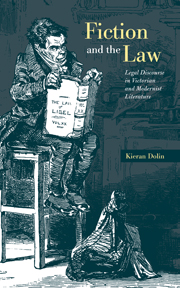Book contents
- Frontmatter
- Contents
- Acknowledgments
- 1 Narrative forms and normative worlds
- 2 The modern Western nomos
- 3 True testimony and the foundation of nomos – The Heart of Midlothian
- 4 Reformist critique in the mid-Victorian “legal novel” – Bleak House
- 5 Representation, inheritance and anti-reformism in the “legal novel” – Orley Farm
- 6 Power, chance and the rule of law – Billy Budd, Sailor
- 7 From sympathetic criminal to imperial law-giver – Lord Jim
- 8 Freedom, uncertainty and diversity – the critique of imperialist law in A Passage to India
- 9 Settling out of court
- Notes
- Index
4 - Reformist critique in the mid-Victorian “legal novel” – Bleak House
Published online by Cambridge University Press: 18 December 2009
- Frontmatter
- Contents
- Acknowledgments
- 1 Narrative forms and normative worlds
- 2 The modern Western nomos
- 3 True testimony and the foundation of nomos – The Heart of Midlothian
- 4 Reformist critique in the mid-Victorian “legal novel” – Bleak House
- 5 Representation, inheritance and anti-reformism in the “legal novel” – Orley Farm
- 6 Power, chance and the rule of law – Billy Budd, Sailor
- 7 From sympathetic criminal to imperial law-giver – Lord Jim
- 8 Freedom, uncertainty and diversity – the critique of imperialist law in A Passage to India
- 9 Settling out of court
- Notes
- Index
Summary
A reviewer of the first number of Bleak House anticipated that Jarndyce and Jarndyce would “doubtless be a famous cause – and take its future place beside the Common Pleas case of Bardell v Pickwick in the Law Reports of Fiction.” This prediction has proved true in the long term. When the serialization of the novel was completed, the same reviewer criticized Dickens for failing “to keep the mighty mystery of Iniquity and Equity perpetually before the reader,” and for giving, instead, “the first concern and sympathy … to Lady Dedlock's secret.” These remarks provide a compact starting-point for a critical and historical discussion of the representation of law in Bleak House. In the first section of this chapter I explore the mid-Victorian evolution of a sub genre based on “the Law Reports of Fiction,” and argue that although Bleak House emerged from this generic field, its critique of the English legal system and nomos is more profound than that of The Heart of Midlothian. The specific focus of this critique, the Court of Chancery, had become a national scandal, obstructing inherited notions of justice and resisting attempts at reform. The sense of contradiction expressed in the phrase, “the mighty mystery of Iniquity and Equity,” is emplotted in Bleak House, which presents the stories of the institution's victims as evidence of the need for reform, but which also recuperates part of the tradition of Equity as an alternative to Chancery. That alternative is best embodied in Esther Summerson.
- Type
- Chapter
- Information
- Fiction and the LawLegal Discourse in Victorian and Modernist Literature, pp. 71 - 96Publisher: Cambridge University PressPrint publication year: 1999
- 1
- Cited by



